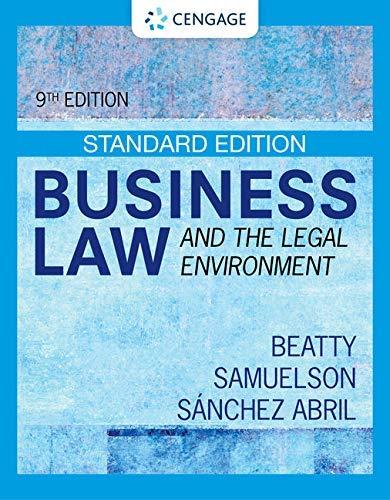Question
Question 2 (20 points). At approximately 10pm, neighbors heard loud gunshots and immediately called 911. When the police officers who responded to the 911 emergency
Question 2 (20 points). At approximately 10pm, neighbors heard loud gunshots and immediately called 911. When the police officers who responded to the 911 emergency call arrived at the scene, they discovered a woman dead inside the entryway of her home with the door wide open. The officers observed that the woman had been killed with a rifle and five .223 Remington cartridges were found scattered near the body. There was no evidence of forced entry, but a partial footprint from a men's size ten shoe was lifted from the front steps. The officers then interviewed the neighbors who reported the woman lived alone but had a boyfriend who frequently spent time at her place. The neighbors could not recall if they had seen him the night of her death. Two detectives were assigned to lead the investigation. Both were experienced homicide investigators who had transferred from the local narcotics unit five years ago. The day after the woman's body was discovered, the detectives interviewed the woman's family who lived in the local area and her coworkers. The detectives learned that the defendant, the victim's boyfriend and a convicted felon who works at a local supermarket, may have been involved in her death. The detectives subsequently obtained a valid search warrant allowing them to search defendant's residence and the surrounding premises. The warrant specifically allowed the detectives to search for a "Remington rifle" and ".223 ammunition." That evening, the detectives executed the search warrant. When they entered defendant's property through the attached garage, they saw what appeared to be several baggies containing white crystals and a makeshift lab setup on a folding table in the garage with plastic bottles, several packets of pseudoephedrine cold medicine, paint thinner, acetone, iodine crystals, and battery acid. Based on their training and experience and the close proximity of the ingredients in the makeshift lab, the detectives believed that the ingredients were used to make the illegal drug crystal meth. Accordingly, the detectives seized these items. Laboratory testing later revealed that the contents of the baggies and the residue on the plastic bottles was consistent with crystal meth. The detectives found three .223 Remington cartridges inside of a small cigar box on top of the dresser in a bedroom in defendant's house. They also found an unsecured Remington rifle under the bed. Several shirts emblazoned with the local supermarket's name and logo were hanging in the closet and three pairs of men's size ten shoes were sitting on the floor of the closet. The detectives arrested defendant after they searched his home. After the detectives read defendant his Miranda rights, they asked him several questions about the rifle found under the bed. The defendant told the detectives "I have no idea what you're talking about." Defendant, however, later confirmed that the detectives found the rifle under his bed and that he owned the house. Defendant also told the detectives that the rifle was "not loaded." When the police arrested the defendant, he appeared to be dressed for work wearing a shirt with the name and logo of the local supermarket and size ten sneakers. A receipt for the purchase of .223 Remington cartridges was found in the defendant's pocket when he was searched following his arrest. Defendant was charged with first-degree murder, possession of crystal meth with intent to distribute, and possession of a firearm as a convicted felon. At a pretrial hearing, defendant moved to suppress the drugs and drug-related materials and the .223 Remington cartridges that were seized from his home, claiming that the seizures of these items violated his rights under the Fourth Amendment of the U.S. Constitution. Although defendant conceded that the search warrant was facially valid, he argued that the warrant did not allow the detectives to seize any drugs or drug-related materials from his home. He also argued that the warrant did not allow the detectives to search in places that were too small to contain a rifle. The court denied defendants motions. Part A: Was the trial court correct to deny defendant's motion to suppress the drugs and drugrelated materials? Explain. Part B: Was the trial court correct to deny defendant's motion to suppress the .223 Remington cartridges recovered from the cigar box? Explain.
Step by Step Solution
There are 3 Steps involved in it
Step: 1

Get Instant Access to Expert-Tailored Solutions
See step-by-step solutions with expert insights and AI powered tools for academic success
Step: 2

Step: 3

Ace Your Homework with AI
Get the answers you need in no time with our AI-driven, step-by-step assistance
Get Started


